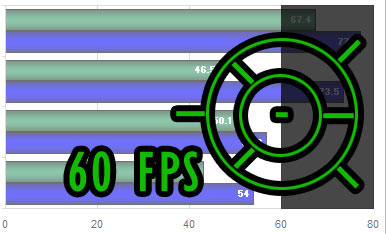Gamers: Do You Need More Than An Athlon II X3?
AMD's Athlon II X3 440 is such a capable little chip, and and it costs so little. Is there any real point in spending more money on your gaming machine’s CPU? We explore this question with a head-to-head challenge against Intel's venerable Core i7-920.
Game Performance Targets
Knowing all of this, we will conclude that a PC user with a 60 Hz monitor can certainly perceive up to 60 FPS. This is a widely accepted performance target for PC games, and now it's a little clearer why.
Finally, we need to consider how we measure game performance. Often, for a quick indicator, we record the average FPS. The problem is that average FPS is an aggregate number that doesn't tell us how low the frame rate can go. You can experience an average of 60 FPS that dips down to 10 FPS during demanding parts of the game, and 10 FPS is choppy by everyone's standards.
Because of this, you should pay attention to minimum FPS. Ideally, the minimum FPS value is 60, but a minimum FPS of 30 or even 20 can be acceptable if it happens for very short stints in demanding parts of a game.
Even the type of game you're playing can determine whether a certain minimum FPS is acceptable. In a first-person shooter, that lag might be enough to mess with your aim during a heated battle. But in a top-view, real-time strategy game, the drop in frame rate probably won't have much of an effect on your view or your click-and-drag inputs.
This is a lot of information to assimilate, but it is critical for the purposes of our review. Remember, we're trying to find out whether or not there is a point in purchasing a CPU that is more expensive than an Athlon II X3 440 for gaming purposes. Now, we know any frame rate advantage over 60 FPS is somewhat useless, but that any minimum frame rate advantage up to 60 FPS can be critical.
Get Tom's Hardware's best news and in-depth reviews, straight to your inbox.
Current page: Game Performance Targets
Prev Page How Much Game Performance Can We Perceive? Next Page Test Systems And BenchmarksDon Woligroski was a former senior hardware editor for Tom's Hardware. He has covered a wide range of PC hardware topics, including CPUs, GPUs, system building, and emerging technologies.
-
welshmousepk good read, though unsurprising. certainly justifies these lower end processors in gaming rigs.Reply
the whole thing seems to slightly contradict the 'balanced PC' articles though. why put such a cheap CPU in a system with such a powerful GPU? is the budget really going to be THAT tight? -
sohei good point in this article....if you have money ....you have 1 solution for every application you run on your pc....(high end cpu) folks with money dont have to think...is simple ...but if you have less money to spend ...an AMD cpu is your (my) choiceReply -
Verkil Still no GTA4? I'm still having thoughts getting an Athlon II X3 because I'll be playing GTA4 and all your Athlon II X3 gaming benchmark does not include GTA4.Reply -
slinkoguy Looks like you guys got a Deneb core. Unlock that thing and let us see those results! :DReply -
haplo602 hmm ... I see an interesting pattern here. the latest Intel architecture is 3x as expensive yet an AMD cpu on a generation older architecture can still keep up reasonable.Reply
except very high end gaming, I realy do not see a reason to go after the i7.
what I am missing from the article is the X3 vs Intel cpus in the same price range. maybe a followup would do some good :-) -
tacoslave should have overclocked the 440 because thats what most will be doing when they use this processor for gamingReply -
Jarmo tacoslaveshould have overclocked the 440 because thats what most will be doing when they use this processor for gamingReply
I'd guess at least 90% of users never overclock anything.
To be fair though, probably 90% of Tom's readers do. -
Stardude82 Do it again with a 5750 or a GTS 250..or lower with a 5650 and a GT 240. You know something modern, but not in excess of the cost of the motherboard and CPU. This is my same problem with the G6950/720 article.. I don't think I've ever seen a good article showing differences with difference CPU's in the middle end. With more of a GPU is bottle neck, the CPU should matter even less.Reply -
HalfHuman nice comparison. seems that the triple core is quite strong enough for gaming. i believe that xfire is crazy technology though and only an almost negligible number of gamers use it. i also do not see the point of using such a strong(expensive) video card with a budget cpu. a money conscious gamer would get a 57xx or something in that zone.Reply
my thought is that for single card users (not necessarily 58xx type not because it's not good but is for sure not budget friendly) and normal monitors (1680x1050) a triple or even dual core amd is enough.
